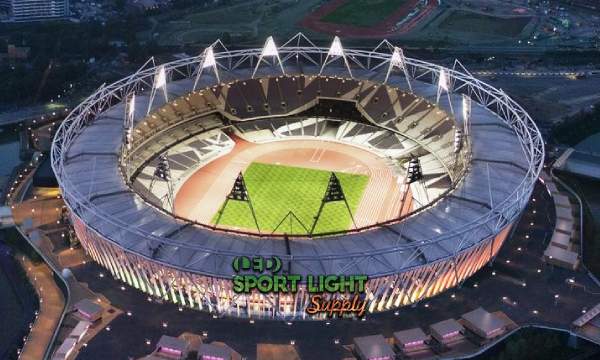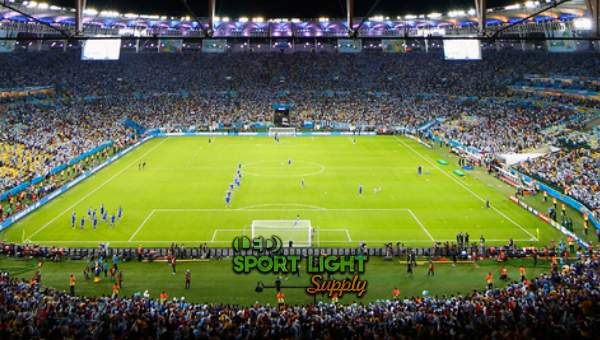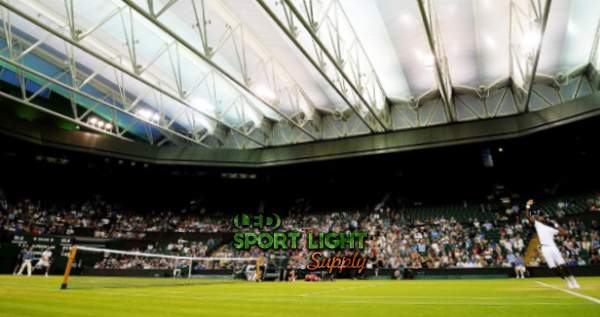For international sports events, lighting is more than just illumination; it is about creating an environment where athletes can perform at their best and spectators can experience the event in its full glory. High-quality sports lighting ensures uniformity, minimizes glare, and supports the precise capture of fast-moving action by high-definition cameras.
The standards for sports lighting vary depending on the sport, the level of the competition, and the venue. However, the common objective is to provide consistent, high-quality lighting that meets the visual needs of both athletes and spectators.
Table of Contents
Toggle The Olympic Games represent the highest standard in international sports competitions, and the lighting requirements reflect the prestige and scale of the event. Olympic venues are designed to accommodate various sports, each with its own set of lighting specifications.
The Olympic Games represent the highest standard in international sports competitions, and the lighting requirements reflect the prestige and scale of the event. Olympic venues are designed to accommodate various sports, each with its own set of lighting specifications.
For outdoor sports like athletics and football, the lighting systems are designed to provide horizontal illuminance of at least 2,000 lux on the field, ensuring that every movement is clearly visible to the audience and the cameras. Indoor venues, such as those used for gymnastics or swimming, require even more precise lighting to highlight the athletes’ performance without causing any distractions or shadows.
The lighting for the Olympics is also designed with energy efficiency in mind, incorporating LED technology that provides both environmental benefits and superior light quality. The system must be flexible enough to accommodate different sports and ceremonies while maintaining consistent brightness and color temperature.
 The FIFA World Cup is the most-watched sporting event in the world, with billions of viewers tuning in to watch the matches. The lighting requirements for the World Cup are among the most stringent, designed to ensure that the games are broadcast in the highest possible quality.
The FIFA World Cup is the most-watched sporting event in the world, with billions of viewers tuning in to watch the matches. The lighting requirements for the World Cup are among the most stringent, designed to ensure that the games are broadcast in the highest possible quality.
FIFA mandates a minimum of 2,000 lux for horizontal illuminance across the entire field, with a uniformity ratio of at least 0.7 to avoid any dark spots. Vertical illuminance, which is crucial for capturing players’ faces and movements in detail, is also emphasized, particularly in the areas close to the goals. The lighting must be free from flicker to prevent issues with slow-motion replays and ensure that the action is captured smoothly.
Moreover, FIFA requires that the lighting system be designed to minimize glare, both for the players on the field and the spectators in the stands. The use of LED lighting, with its ability to provide instant-on capabilities and high color rendering index (CRI), is increasingly common in World Cup stadiums, helping to create a vibrant and immersive viewing experience.
 The Super Bowl is the pinnacle of American football, watched by millions across the globe. The lighting requirements for this event are tailored to the unique demands of the sport, where the combination of speed, strategy, and spectacle is paramount.
The Super Bowl is the pinnacle of American football, watched by millions across the globe. The lighting requirements for this event are tailored to the unique demands of the sport, where the combination of speed, strategy, and spectacle is paramount.
The NFL specifies that stadium lighting must provide a minimum of 1,500 lux on the playing field, with an emphasis on uniformity to ensure that there are no shadows or unevenly lit areas. The lighting design must also account for the fast-paced nature of the game, ensuring that every moment is captured in crisp detail by the broadcast cameras.
One of the distinctive aspects of Super Bowl lighting is its role in enhancing the event’s entertainment value. The halftime show, which features performances by some of the biggest names in music, requires a lighting system that can seamlessly transition from sports lighting to concert lighting. This involves complex lighting cues, color changes, and dynamic effects, all of which must be synchronized with the broadcast.
 Wimbledon, the oldest and most prestigious tennis tournament in the world, has unique lighting requirements that reflect the traditional and precise nature of the sport. The All England Club, where Wimbledon is held, has invested in state-of-the-art lighting systems that ensure the tournament can proceed regardless of natural light conditions.
Wimbledon, the oldest and most prestigious tennis tournament in the world, has unique lighting requirements that reflect the traditional and precise nature of the sport. The All England Club, where Wimbledon is held, has invested in state-of-the-art lighting systems that ensure the tournament can proceed regardless of natural light conditions.
For tennis, lighting uniformity is crucial to ensure that the ball’s trajectory is clearly visible from all angles. Wimbledon’s courts are illuminated with a minimum of 1,500 lux, with a high uniformity ratio to eliminate shadows that could interfere with play. The color temperature is carefully controlled to provide a natural and comfortable viewing experience, both for spectators in the stands and for television audiences.
In addition to the court lighting, Wimbledon also employs advanced lighting controls to manage the ambient light levels within the venue. This is particularly important during the evening matches, where the transition from natural to artificial lighting must be smooth and unobtrusive.
While each major sporting event has its own specific lighting requirements, there are some common standards that apply across different sports. These standards are often set by international governing bodies such as the International Association of Athletics Federations (IAAF), the Fédération Internationale de Football Association (FIFA), and the International Tennis Federation (ITF).
Horizontal illuminance is a fundamental aspect of sports lighting, referring to the amount of light that is spread across the playing surface. It is measured in lux, a unit that quantifies the intensity of light perceived by the human eye on a surface. The requirements for horizontal illuminance vary greatly depending on the type of sport, the size of the playing field, and the specific conditions under which the sport is played.
For sports like football (soccer) and athletics, which are often played on expansive outdoor fields, the horizontal illuminance typically ranges from 1,500 to 2,000 lux. This level of illumination ensures that every corner of the field is evenly lit, providing optimal visibility for players, referees, and spectators alike. The uniform distribution of light is crucial in these sports because it helps prevent uneven lighting that could create shadows or dark spots, which might impede the athletes’ ability to see the ball, track, or each other.
In sports like baseball and cricket, where the playing fields are larger and the action is more spread out, the requirements for horizontal illuminance can be even higher. These sports often require levels above 2,000 lux, particularly in key areas such as the pitcher’s mound, batter’s box, and cricket pitch. Higher lux levels are necessary to ensure that the ball, which is often small and fast-moving, remains visible to players and cameras at all times.
The need for precision in lighting becomes even more apparent in situations where games are played under varying weather conditions or at night. In these scenarios, maintaining consistent horizontal illuminance is vital for the fairness and safety of the game. For example, during an evening football match, the lighting must compensate for the lack of natural light, ensuring that the game can proceed without interruption or visual impediments.
Vertical illuminance refers to the amount of light that falls on vertical surfaces, such as the players themselves, the ball, and other vertical objects within the sports arena. This type of illuminance is particularly important for sports broadcasting, as it directly impacts the clarity and quality of the images captured by cameras.
For broadcasting purposes, vertical illuminance ensures that the athletes are well-lit from various angles, allowing cameras to capture their movements, expressions, and interactions in detail. This is essential not only for live broadcasts but also for replays and slow-motion footage, which often zoom in on players’ faces and actions. The required levels of vertical illuminance vary depending on the sport and the specific broadcasting needs, but they are generally around 1,000 lux or higher.
In sports like tennis, vertical illuminance is crucial for following the fast-paced exchanges between players. The ball and players must be visible from all angles, especially in close-up shots. In team sports such as basketball or volleyball, where players frequently jump or move vertically, vertical illuminance helps ensure that their movements are clearly visible against the background.
In addition to its importance for broadcasting, vertical illuminance also affects the experience of spectators in the venue. Proper vertical illuminance enhances the visual contrast between the players and the field, making it easier for the audience to follow the action from different vantage points. This is particularly important in large stadiums where the distance between the spectators and the playing field can be significant.
The uniformity ratio in sports lighting refers to the ratio of the minimum illuminance to the average illuminance across the playing surface. This ratio is a critical factor in ensuring that the lighting is consistent and evenly distributed, without significant variations in brightness that could affect gameplay or viewing quality.
A high uniformity ratio is essential because it prevents the occurrence of dark spots or overly bright areas on the field, which can disrupt the athletes’ performance and the audience’s viewing experience. For most sports, a uniformity ratio of at least 0.7 is required, meaning that the darkest areas of the playing surface should not be less than 70% of the average brightness. This ensures a balanced lighting environment where athletes can perform without being hindered by poor visibility in certain parts of the field.
In sports like golf, which takes place on large, uneven terrains, achieving a high uniformity ratio can be particularly challenging. The lighting design must account for variations in elevation and distance to ensure that the entire course is uniformly lit. In indoor sports like basketball or ice hockey, where the playing area is more contained, achieving a high uniformity ratio is crucial for maintaining visual consistency, especially when players move rapidly across the court or rink.
For broadcast purposes, uniformity is equally important. Inconsistent lighting can lead to poor video quality, with some areas appearing washed out while others are too dark to capture details. Achieving a uniform lighting environment is a complex process that requires precise positioning of lights and careful calibration of their output.
Glare is a common issue in sports lighting, where intense light can cause discomfort or distraction for both athletes and spectators. Glare occurs when the brightness of light sources is too high relative to the ambient light levels, causing visual discomfort or impairing visibility. In the context of sports, glare can significantly affect performance and safety, making glare control a critical component of sports lighting design.
Glare control is particularly important in outdoor stadiums where natural light from the sun can combine with artificial lighting to create challenging visual conditions. In these environments, lighting systems are often designed with shields, louvers, or specific fixture placements to minimize direct glare. These measures help to control the direction and intensity of light, reducing its impact on players’ vision and preventing distractions.
For indoor arenas, glare control involves careful consideration of the placement and orientation of lighting fixtures. The goal is to ensure that the lights do not shine directly into the athletes’ eyes or into the eyes of spectators. This is especially important in sports like basketball or volleyball, where players frequently look upward toward the ceiling or high nets.
Another critical aspect of glare control is the use of technology such as anti-glare coatings on lighting fixtures. These coatings help diffuse light and soften its impact, reducing the risk of glare while maintaining adequate illumination levels. Advanced lighting systems also incorporate adjustable fixtures that can be angled or dimmed to suit specific needs during a game or event.
Effective glare control enhances not only the comfort and performance of the athletes but also the overall spectator experience, ensuring that the focus remains on the action without unnecessary visual disturbances.
The Color Rendering Index (CRI) is a measure of a light source’s ability to accurately render the colors of objects as they would appear under natural sunlight. CRI is measured on a scale from 0 to 100, with higher values indicating better color rendering capability. In sports lighting, a high CRI is essential for ensuring that the colors on the field, court, or track are vivid and true to life.
For live spectators, a high CRI enhances the visual experience by making the colors of team uniforms, equipment, and the playing surface more vibrant and distinguishable. This is particularly important in sports where team colors are an integral part of the game, such as in football or basketball. Inaccurate color rendering can make it difficult for spectators to distinguish between teams, leading to confusion and a less enjoyable viewing experience.
For television broadcasts, a high CRI is crucial for maintaining image quality. Poor color rendering can result in dull or washed-out images, affecting the overall broadcast quality. This is especially important for high-definition and ultra-high-definition broadcasts, where viewers expect crisp, clear images with accurate colors. A CRI of 80 or higher is typically required for sports lighting to meet the demands of modern broadcasting standards.
In addition to enhancing the visual experience, a high CRI also contributes to the safety of the game. Accurate color rendering helps players and referees distinguish between the field markings, uniforms, and equipment, reducing the risk of errors or accidents during play.
Flicker-free lighting is an essential requirement for modern sports events, particularly in the context of high-definition and slow-motion broadcasting. Flicker refers to the rapid fluctuation in light output that can occur with some lighting systems, particularly those using older technologies like metal halide lamps. Flicker can cause significant issues in video capture, leading to distorted images, visible flickering on screen, or even missed moments during slow-motion replays.
With the advent of LED technology, flicker-free lighting has become more achievable. LED lights are designed to operate with minimal flicker, providing a steady and consistent light output that is ideal for capturing high-quality video. This is particularly important in sports where slow-motion replays are frequently used to analyze key moments, such as in football or tennis.
Flicker-free lighting also improves the experience for live spectators, reducing the visual strain that can be caused by flickering lights. This is especially relevant in indoor arenas or stadiums where the artificial lighting is the primary source of illumination.
For broadcasters, flicker-free lighting is a necessity to ensure that the images captured by cameras are clear and free from distortion. This is not only important for live broadcasts but also for replays, highlights, and post-event analysis. The ability to capture smooth, flicker-free footage enhances the overall quality of the broadcast and ensures that viewers at home have a seamless viewing experience.
The evolution of sports lighting has been marked by significant technological advancements, particularly with the adoption of LED lighting. LEDs offer numerous benefits over traditional lighting systems, including higher energy efficiency, longer lifespan, and greater control over lighting effects.
LED technology allows for dynamic lighting adjustments, enabling organizers to change the intensity, color, and pattern of the lighting to suit different events and moments within a single event. This flexibility is particularly valuable in multi-use stadiums and during events like the Olympics, where the lighting needs to adapt quickly to different sports and ceremonies.
Moreover, LED systems are more environmentally friendly, reducing energy consumption and minimizing the carbon footprint of large-scale events. As sustainability becomes an increasingly important consideration, the use of LED lighting in sports is expected to continue to grow.
As the demands of world-class sports events continue to evolve, so too will the standards and technologies used in sports lighting. The future will likely see even more sophisticated systems that integrate with smart technology, offering real-time adjustments and greater customization to enhance both the athletes’ performance and the spectators’ experience.
Drop us a line to receive a free lighting design